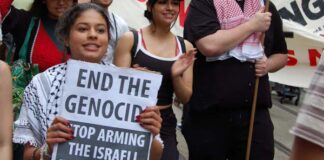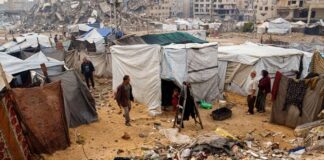As Palestinian children in Gaza restarted school on 14 September, the number of their classmates slaughtered during Israel’s recent war stood at approximately 500, while upwards of 3000 had been injured.
School age children make up almost one quarter of the 2188 Palestinians killed.
More than 200 school buildings were damaged or destroyed during the bombardment, while an estimated 44,300 housing units were affected. One hundred thousand Gazans have been rendered permanently homeless.
Vital infrastructure also lies in ruin. Power is unavailable for 18 hours a day, after Israel hit Gaza’s only power station, already operating at reduced capacity due to the ruthless blockade.
Yet despite its overwhelming firepower and ability to bomb with impunity, Israel has not been able to dislodge Hamas and put out the flame of Palestinian resistance.
Last time Israel attacked Gaza Prime Minister Netanyahu, then in opposition, blustered that, “the action that is required is something that removes this Hamas regime from the scene.” This time he’s been forced to concede such an effort would be far too costly.
During the war, Hamas had refused any ceasefire without agreement that Israel would lift the crippling siege, a demand backed overwhelmingly by Gaza’s population. Reports from the ceasefire negotiations said Israel had conceded some liberalisation of flows of people and goods at the border crossings.
But on the ground at the checkpoints, nothing has changed.
This makes reconstruction work virtually impossible. Gazan economist Maher al-Tabbaa told Reuters, “You would safely need 10,000 tonnes of cement per day for six months”. Before the war an average of just 30 tonnes of cement per week crossed the border.
One widely reported concession made by Israel was a commitment that Palestinian fishermen could take their boats beyond the limit of three nautical miles from shore imposed by the Israeli Navy.
However, Nizar Ayyash from the Union of Gaza Fishermen told the Ma’an news agency that Israeli gunboats had conceded no extra distance and “have been firing at fishermen every day since the ceasefire agreement was signed”.
West Bank expansion
Meanwhile, in the West Bank, Israel has announced the confiscation of approximately 1000 hectares of private Palestinian land, much of it used for olive farming.
Israeli settlement watchdog Peace Now said, “As far as we know, this declaration is unprecedented in its scope since the 1980s and can dramatically change the reality in the Gush Etzion and the Bethlehem areas”.
Even Australian Foreign Minister Julie Bishop conceded that the land confiscation was “unhelpful” given international efforts to ensure the ceasefire holds.
Israel is also pushing ahead with plans to forcibly relocate thousands of Palestinians living in Bedouin communities in the West Bank into a single township. A joint statement from 42 Palestinian, Israeli and International NGOs condemned the move, saying that Israel was using “coercive tactics to heighten the pressure on Palestinian Bedouin communities, issuing eviction orders and demolishing homes and livelihood structures”.
Counter-revolution
Both Israel’s war on Gaza and its new expansion in the West Bank need to be seen in light of the retreat of the Arab revolutions, which exploded in 2011 against dictatorships backed by imperialism right across the Middle East.
Israel’s position as a watchdog of Western Imperialism in the region rests not just on the enormous flow of military support from the US, but from the support of Arab dictatorships.
The revolution in Egypt in particular created new hope, given the central role played by toppled Egyptian dictator Hosni Mubarak in supporting Israel’s siege of Gaza.
But the Muslim Brotherhood government that came to power, and who Hamas came to rely upon, did little to break the siege and failed to deliver gains to the Egyptian masses. They were ousted by a coup in 2013. As the General Sisi massacred Brotherhood supporters in Egypt, Israel knew it could turn up the heat on Gaza.
Even before the war, Hamas’ growing isolation had forced them into co-operation with the hated Palestinian Authority (PA), who effectively run an outsourced occupation for Israel in the West Bank. The PA are now set to take over most of the reigns of government in Gaza.
PA President Mahmoud Abbas is positioning himself as a key player in the desperately needed “reconstruction”, announcing a deal with Israel and the UN to allow supplies for reconstruction into Gaza without any reference to Hamas.
But Israel’s brutality has led it to lose further ground in public opinion globally. The wave of protest during the war internationally showed a further deepening of support for the Palestinians, especially in the US.
Such solidarity can both give heart to the Palestinians and encourage the revival of the Arab revolutions necessary to bring real liberation.
By Paddy Gibson





